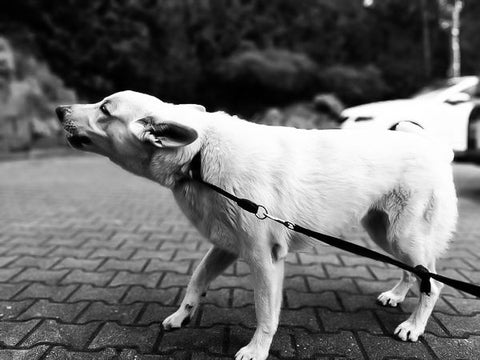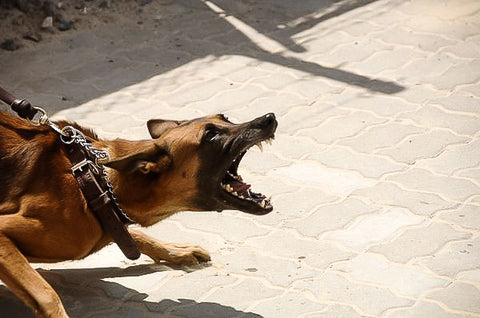If you have a dog with aggression issues, it may be time to consider hiring professional dog trainers. The thing is, what do you look for? Here at Lolahemp, we want to help dog lovers find the best resources to make sure their pets have the support they need.
Do any of the following quotes resonate with you?
~
“She’s a sweet dog unless you try to take away her favorite toy.”
~
“He gets along great with everyone unless he’s sitting in someone’s lap - then he gets snappy with a possessive aggression.”
~
“We used to enjoy the dog park but after a recent dog fight, she has been very nervous around other dogs.”
~
“He’s fine with other dogs in the park but he is a terror when he meets other dogs on a leash.”

When Should Pet Owners Seek Behavior Consultants?
As you can see, dog aggression takes many forms. This complex behavior has many potential causes, including:
- trauma
- resource scarcity
- abuse
- neglect
- poor socialization
- phobias
- plain old personality
That being said, a lot of dog aggression starts with fear or anxiety.
Unfortunately, handling fear aggression with “common sense” can sometimes make an aggressive dog more dangerous. Here’s a prime example: If you choose to “dominate” your dog every time they give an aggressive warning signal (frozen stance, snarled lips, or a growl), you may actually be training your dog to stop giving warning signals without addressing the root cause of their fear and anxiety.
Next time, the dog may go right to a bite when triggered...definitely not the desired effect! If you have been trying to help your dog deal with dog aggression on your own and noticed the problem getting worse, then odds are good that your well-meaning efforts may be getting lost in translation.
A professional dog trainer may be able to help you gain a new perspective on aggression issues and help you develop a plan that will help your dog recover from the root fears and anxieties that cause this behavior.
Which Dog Training Paradigm is Best for Aggressive Behavior?
The popularity of some television shows which promote the “dominance model” of dog training has perpetuated an outdated myth about dogs. This myth is based on a few faulty assumptions.
The first assumption is that dogs are still essentially wolves (they aren’t). The second one is that all dog learning can be boiled down to pack order (which it can’t).
The last 60 years of careful scientific study on animal behavior has demonstrated beyond any doubt that dogs, just like people, learn from reward and punishment. Punishment is most effective if used sparingly, and only after appropriate behaviors have been significantly reinforced through judicious use of reward.
When it comes to the fear and anxiety at the root of dog aggression, it turns out that dominating your dog is almost always a form of punishment from their perspective. Dominance punishes the response (aka the warning signs) which actually increases anxiety and fear.
This deepens the emotional response to the original trigger.
Imagine for a moment that you are afraid of spiders. Let’s say when you see a spider, you show this fear by letting out a quick shout. Now imagine a well-meaning friend is trying to help you get over your fear of spiders by pinching you every time you shout.
Every time you see a spider and shout, you get a painful pinch. Are you going to be less afraid of spiders? Probably not. In fact, you may even become more afraid of spiders since now you have a painful pinch associated with their presence.

What Should I Look for In a Good Trainer or Training Program?
1. Experience With Aggression Training
Look for a trainer who specializes in dog aggression. Just because someone knows how to teach a dog basic manners and walk on a leash doesn’t mean they have the experience to work on the complex issue of dog aggression.
2. Operant Conditioning/Positive Reinforcement
Look for trainers who use operant conditioning, sometimes referred to as a positive reinforcement-based model. They are likely to use terms such as reconditioning and desensitization which refer to different processes used in animal behavior research.
While they may use some punishment, they do so sparingly and thoughtfully. Punishment usually includes taking something good away from the dog (a toy, for example) rather than applying direct punishment such as scare tactics or physical pain (especially when there are aggression issues present).
3. Find Trainers Who Diagnose Anxiety Triggers
Look for trainers who start the process by trying to diagnose the specific anxiety triggers that your individual dog has, rather than trying to apply a one-size-fits-all approach. Be prepared: they may identify some of your behaviors that could be contributing to the problem and ask you to change some of your responses in situations when your dog is triggered.
4. Contact Previous Clients
Ask for references and then contact them. A lot of pet owners may feel a little bit sheepish about calling around to talk to a few past clients, but it is perfectly appropriate to do so. After all, many people are desperate to help their dogs overcome debilitating aggression since whether or not to rehome their pet may be on the line. As a result, there are plenty of less-than-competent trainers out there capitalizing on this need.
5. Trust Your Instincts
When you narrow down your list meet with dog trainers, keep looking if you get a bad vibe or sense that the person doesn’t really “connect” with your dog. As an advocate for your dog’s best interests, it is perfectly okay to be picky!
Should I Use Tranquilizers When My Dog is Acting Aggressively?
In the vast majority of cases, the answer to this question is no.
Exceptions include situations where you know your dog may behave aggressively and become dangerous to himself or others and there is no alternative. For example, some people use tranquilizers to go to the vet if their dog is particularly triggered by this experience.
Tranquilizers for aggressive dogs have a major downside: they can interfere with the bite inhibition of your dog. Dogs learn just how hard to bite through practice and play. This valuable, learned behavior can make the difference between a bite that breaks the skin and one that leaves a minor bruise.
Tranquilizers can cause your dog to elicit aggression instead of showing what was intended as a minor warning bite. That said, you may want to consider a natural product to calm your dog without sedating her: Lolahemp organic CBD oil for dogs.
In fact, this hemp extract may even help with your training efforts by raising what is known as the reaction threshold (the intensity of exposure to a trigger). This gives you more room to reward calm behavior in the presence of a trigger, a critical part of any useful reconditioning program.
In this way, CBD oil may speed up well-designed dog aggression training programs. Many professional trainers and dog owners alike have found it to be helpful in cases of dog aggression.
References:
https://lolahemp.com/blogs/news/cbd-oil-dog-aggression
https://lolahemp.com/


Comment
My dog gets aggressive he doesn’t like my grand daughters, Growling to them when they want to pet him, he gets very aggressive like it wants to attack he doesn’t like
Other dogs, he doesn’t like to walk on the street ,I believe he’s a very nervous dog and he’s afraid of everything he’s a good Doug to me ,I love him very much , . he likes to play with my daughters . And he doesn’t like people to pet him he walks back and he hides behind me. They are a few people that he likes but he’s very timid I don’t know what to do.